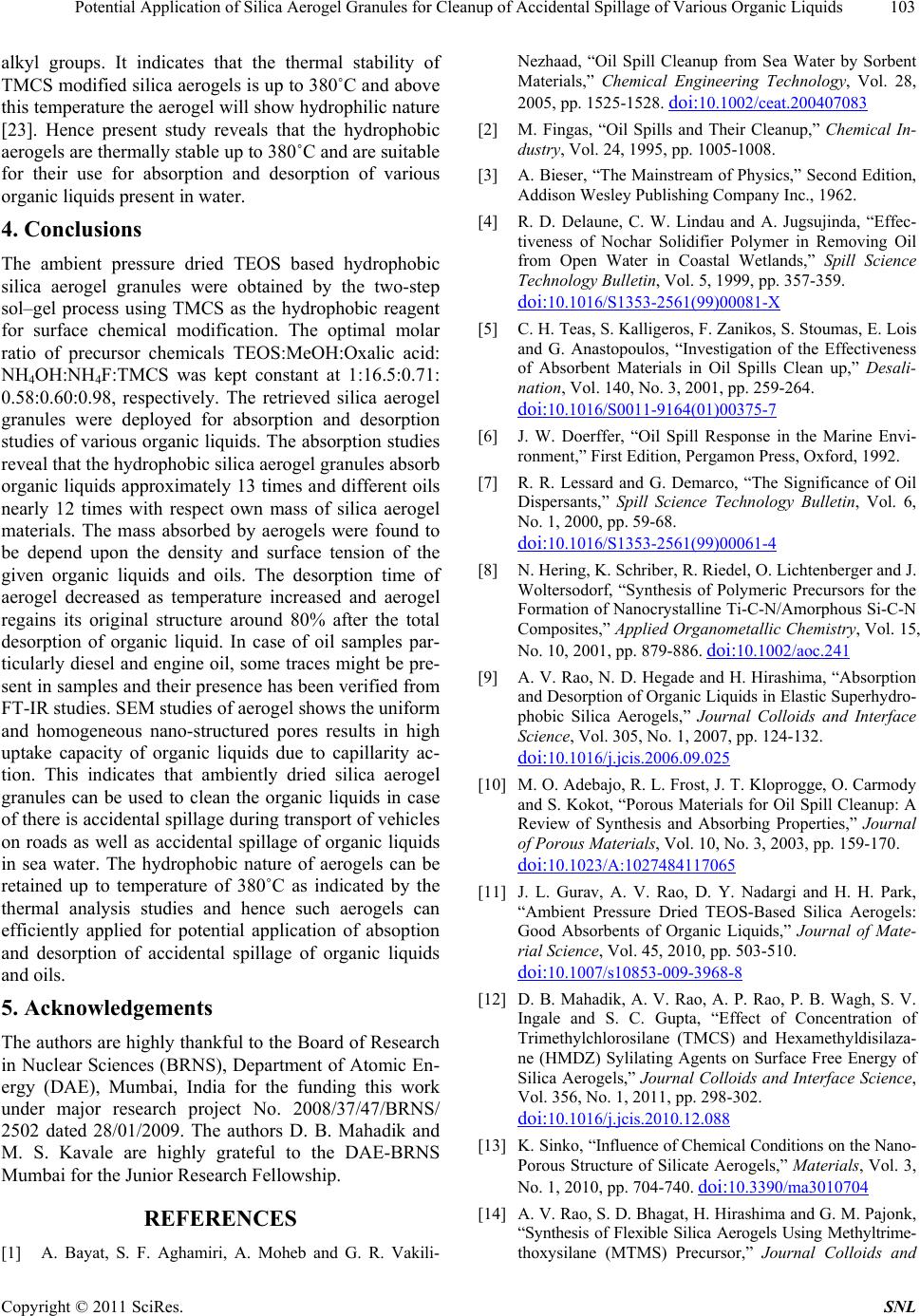
Potential Application of Silica Aerogel Granules for Cleanup of Accidental Spillage of Various Organic Liquids103
alkyl groups. It indicates that the thermal stability of
TMCS modified silica aerogels is up to 380˚C and ab ove
this temperature the aerogel will show hydrophilic nature
[23]. Hence present study reveals that the hydrophobic
aerogels are thermally stable up to 380˚C and are suitable
for their use for absorption and desorption of various
organic liquids present in water.
4. Conclusions
The ambient pressure dried TEOS based hydrophobic
silica aerogel granules were obtained by the two-step
sol–gel process using TMCS as the hydrophobic reagent
for surface chemical modification. The optimal molar
ratio of precursor chemicals TEOS:MeOH:Oxalic acid:
NH4OH:NH4F:TMCS was kept constant at 1:16.5:0.71:
0.58:0.60:0.98, respectively. The retrieved silica aerogel
granules were deployed for absorption and desorption
studies of various organic liquids. The absorption studies
reveal that the hydrophobic silica aerogel granules absorb
organic liquids approximately 13 times and different oils
nearly 12 times with respect own mass of silica aerogel
materials. The mass absorbed by aerogels were found to
be depend upon the density and surface tension of the
given organic liquids and oils. The desorption time of
aerogel decreased as temperature increased and aerogel
regains its original structure around 80% after the total
desorption of organic liquid. In case of oil samples par-
ticularly diesel and engine oil, some traces might be pre-
sent in samples and their presence has been verified from
FT-IR studies. SEM studies of aerogel shows the uniform
and homogeneous nano-structured pores results in high
uptake capacity of organic liquids due to capillarity ac-
tion. This indicates that ambiently dried silica aerogel
granules can be used to clean the organic liquids in case
of there is accidental spillage during transport of vehicles
on roads as well as accidental spillage of organic liquids
in sea water. The hydrophobic nature of aerogels can be
retained up to temperature of 380˚C as indicated by the
thermal analysis studies and hence such aerogels can
efficiently applied for potential application of absoption
and desorption of accidental spillage of organic liquids
and oils.
5. Acknowledgements
The authors are highly thankful to the Board of Research
in Nuclear Sciences (BRNS), Department of Atomic En-
ergy (DAE), Mumbai, India for the funding this work
under major research project No. 2008/37/47/BRNS/
2502 dated 28/01/2009. The authors D. B. Mahadik and
M. S. Kavale are highly grateful to the DAE-BRNS
Mumbai for the Junior Research Fellowship.
REFERENCES
[1] A. Bayat, S. F. Aghamiri, A. Moheb and G. R. Vakili-
Nezhaad, “Oil Spill Cleanup from Sea Water by Sorbent
Materials,” Chemical Engineering Technology, Vol. 28,
2005, pp. 1525-1528. doi:10.1002/ceat.200407083
[2] M. Fingas, “Oil Spills and Their Cleanup,” Chemical In-
dustry, Vol. 24, 1995, pp. 1005-1008.
[3] A. Bieser, “The Mainstream of Physics,” Second Edition,
Addison Wesley Publishing Company Inc., 1962.
[4] R. D. Delaune, C. W. Lindau and A. Jugsujinda, “Effec-
tiveness of Nochar Solidifier Polymer in Removing Oil
from Open Water in Coastal Wetlands,” Spill Science
Technology Bulletin, Vol. 5, 1999, pp. 357-359.
doi:10.1016/S1353-2561(99)00081-X
[5] C. H. Teas, S. Kalligeros, F. Zanikos, S. Stoumas, E. Lois
and G. Anastopoulos, “Investigation of the Effectiveness
of Absorbent Materials in Oil Spills Clean up,” Desali-
nation, Vol. 140, No. 3, 2001, pp. 259-264.
doi:10.1016/S0011-9164(01)00375-7
[6] J. W. Doerffer, “Oil Spill Response in the Marine Envi-
ronment,” First Edition, Pergamon Press, Oxford, 1992.
[7] R. R. Lessard and G. Demarco, “The Significance of Oil
Dispersants,” Spill Science Technology Bulletin, Vol. 6,
No. 1, 2000, pp. 59-68.
doi:10.1016/S1353-2561(99)00061-4
[8] N. Hering, K. Schriber, R. Riedel, O. Lichtenberger and J.
Woltersodorf, “Synthesis of Polymeric Precursors for the
Formation of Nanocrystalline Ti-C-N/Amorphous Si-C-N
Composites,” Applied Organometallic Chemistry, Vol. 15,
No. 10, 2001, pp. 879-886. doi:10.1002/aoc.241
[9] A. V. Rao, N. D. Hegade and H. Hirashima, “Absorption
and Desorption of Organic Liquids in Elastic Superhydro-
phobic Silica Aerogels,” Journal Colloids and Interface
Science, Vol. 305, No. 1, 2007, pp. 124-132.
doi:10.1016/j.jcis.2006.09.025
[10] M. O. Adebajo, R. L. Frost, J. T. Kloprogge, O. Carmody
and S. Kokot, “Porous Materials for Oil Spill Cleanup: A
Review of Synthesis and Absorbing Properties,” Journal
of Porous Materials, Vol. 10, No. 3, 2003, pp. 159-170.
doi:10.1023/A:1027484117065
[11] J. L. Gurav, A. V. Rao, D. Y. Nadargi and H. H. Park,
“Ambient Pressure Dried TEOS-Based Silica Aerogels:
Good Absorbents of Organic Liquids,” Journal of Mate-
rial Science, Vol. 45, 2010, pp. 503-510.
doi:10.1007/s10853-009-3968-8
[12] D. B. Mahadik, A. V. Rao, A. P. Rao, P. B. Wagh, S. V.
Ingale and S. C. Gupta, “Effect of Concentration of
Trimethylchlorosilane (TMCS) and Hexamethyldisilaza-
ne (HMDZ) Sylilating Agents on Surface Free Energy of
Silica Aerogels,” Journal Colloids and Interface Science,
Vol. 356, No. 1, 2011, pp. 298-302.
doi:10.1016/j.jcis.2010.12.088
[13] K. Sinko, “Influence of Chemical Conditions on the Nano-
Porous Structure of Silicate Aerogels,” Materials, Vol. 3,
No. 1, 2010, pp. 704-740. doi:10.3390/ma3010704
[14] A. V. Rao, S. D. Bhagat, H. Hirashima and G. M. Pajonk,
“Synthesis of Flexible Silica Aerogels Using Methyltrime-
thoxysilane (MTMS) Precursor,” Journal Colloids and
Copyright © 2011 SciRes. SNL